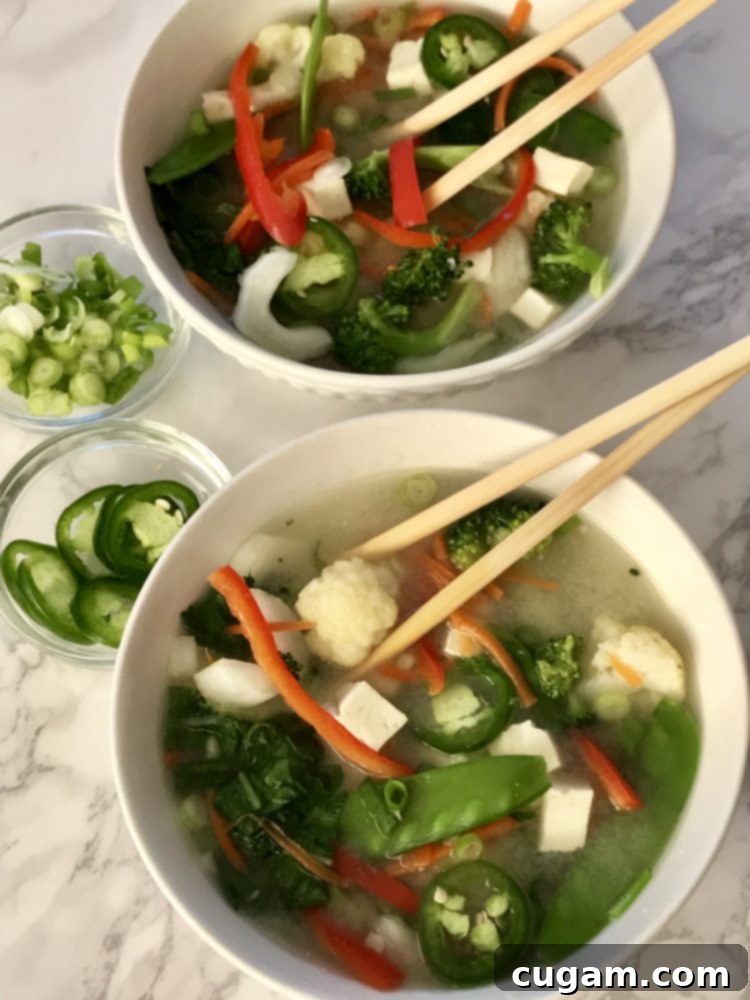Easy & Healthy Miso Soup with Vegetables and Tofu: A Quick 10-Minute Recipe
This Simple Miso Soup Recipe is incredibly easy to prepare, relying on the fresh vegetables you already have on hand. It’s wonderfully light yet deeply satisfying, offering a delightful balance of flavors and incredible versatility. With just a few minutes of prep time for your veggies, this nourishing miso soup with tofu can be ready to enjoy in as little as 10 minutes. It’s a truly brilliant solution for a quick, healthy, and delicious meal!
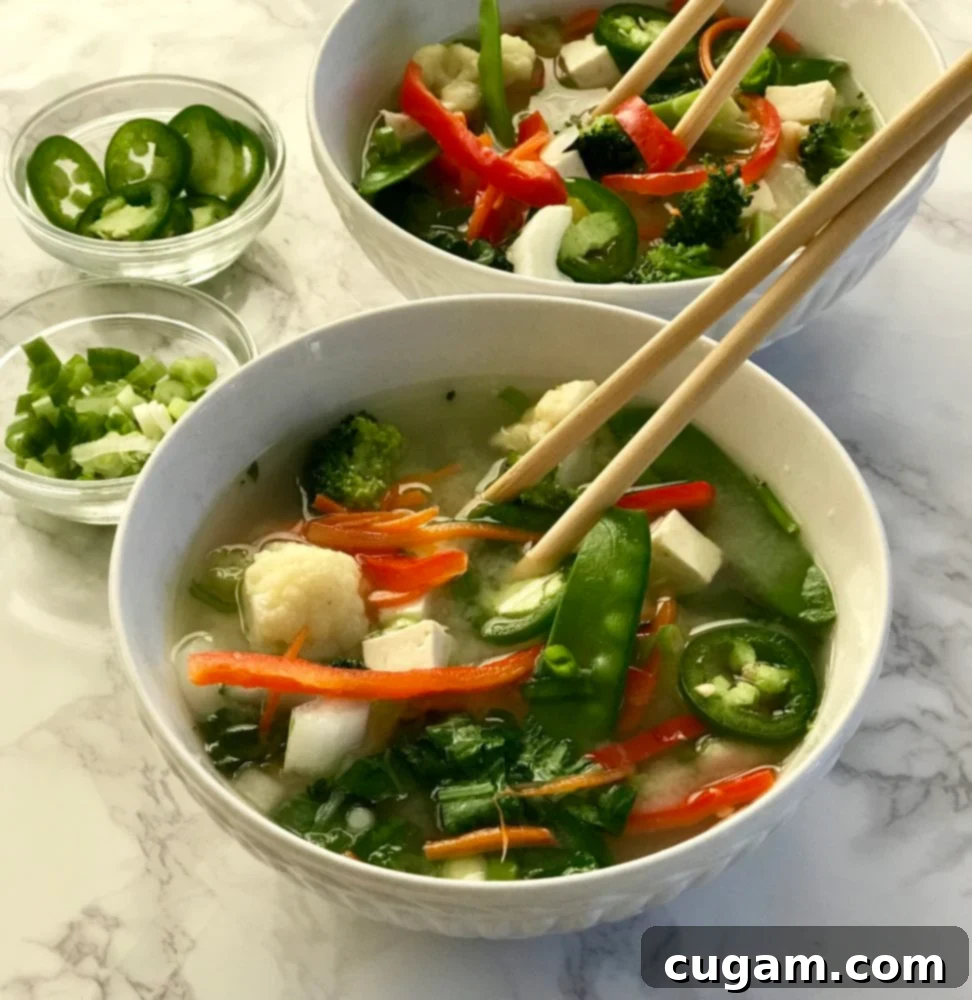
This post has been updated from the original, which was first published on January 1, 2018. The recipe has been refined for even more flavor and clarity.
There’s immense joy in life’s simpler pleasures—and this Easy Miso Soup Recipe is definitely one of them. I absolutely adore how effortlessly I can incorporate a variety of my favorite seasonal vegetables and protein-packed tofu into this rich, wholesome miso broth. It’s a culinary “Wham! Bam! Done!” moment that consistently delivers a delicious, comforting bowl every single time. Whether you’re a seasoned chef or a beginner, this recipe simplifies healthy eating without compromising on taste.
The Wonderful Benefits of Homemade Miso Soup
Beyond its fantastic taste, homemade miso soup offers a myriad of health benefits that make it an excellent addition to your diet. Miso, a fermented soybean paste, is a powerhouse of probiotics, which are crucial for maintaining a healthy gut microbiome. A balanced gut can positively impact everything from digestion to immunity and even mood. This soup is also:
- Rich in Nutrients: Packed with a diverse range of vitamins, minerals, and antioxidants from the variety of fresh vegetables.
- Hydrating: A warm, flavorful broth is a comforting way to stay hydrated throughout the day.
- Low Calorie & Satisfying: It’s light yet surprisingly filling, making it perfect for a healthy lunch or a light dinner.
- Immune Boosting: The ginger and garlic provide anti-inflammatory and immune-supporting properties.
- Versatile & Customizable: Easily adapt it to your dietary needs and what you have on hand, minimizing food waste.
- Quick to Prepare: Ideal for busy weeknights when you need a nutritious meal fast.
Key Ingredients & Flavorful Substitutions for Your Miso Soup
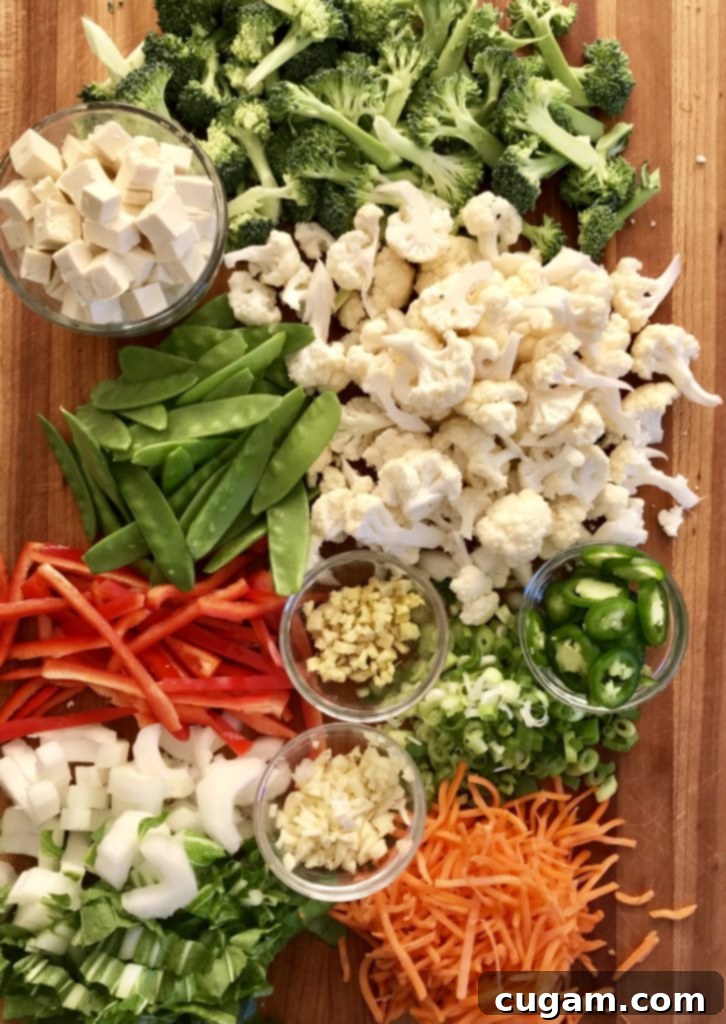
The beauty of this miso soup lies in its flexibility. While I recommend certain ingredients for optimal flavor and texture, feel free to experiment with what you love and what’s in season!
- Miso Paste: I typically use a light yellow or white miso paste. These varieties are milder and slightly sweet, making them perfect for a delicate, balanced soup. You can also use rice miso or chickpea miso for excellent results. This is where the profound umami satisfaction truly begins to build, adding depth that’s impossible to replicate. Ensure you use good quality, organic miso for the best flavor and probiotic benefits.
- Tofu: Opt for firm or extra-firm tofu. These types will hold their shape beautifully in the simmering miso broth, providing a satisfying texture and a good source of plant-based protein. Pressing the tofu beforehand (even for 15-30 minutes) can improve its texture and allow it to absorb more flavor.
- Ginger: Fresh ginger is non-negotiable for the best flavor! It provides a warm, zesty kick and offers significant anti-inflammatory benefits, making your soup both delicious and healing. Peel and mince it finely for maximum impact.
- Garlic: Fresh garlic cloves are essential for building a robust, aromatic base for this vegan soup. Minced garlic, sautéed briefly, releases incredible fragrance and contributes greatly to the overall savory profile.
- Broccoli: Adds a lovely texture and a boost of Vitamin C and K.
- Cauliflower: Similar to broccoli, it brings a mild flavor and hearty florets, rich in fiber and various nutrients.
- Snow Peas: Quick-cooking and provide a delightful crunch and sweetness.
- Bell Pepper: Adds vibrant color, a sweet crunch, and plenty of Vitamin C. Red or yellow bell peppers work wonderfully.
- Bok Choy: This leafy green adds a subtle bitterness and tenderness to the soup. If you love bok choy, you’ll also want to try my ginger scallion bok choy recipe for another delightful way to enjoy it.
- Carrots: Sweet and earthy, carrots add natural sweetness and a beautiful orange hue, along with beta-carotene. Shredding them helps them cook quickly.
- Jalapeno: An optional garnish for those who enjoy a touch of heat, adding a fresh, spicy note.
- Scallions: Also known as green onions, these are a crucial garnish for freshness, mild onion flavor, and a pop of color.
- Broth (Water): While the recipe calls for water, you can certainly elevate the flavor by using a good quality vegetable broth. This will add another layer of savory depth to your soup.
- Oil: A good quality olive oil or sesame oil for sautéing the aromatics.
- Endless Substitutions: The beauty of this recipe is its adaptability. Almost any vegetable you enjoy can be added! Great options include zucchini, kale, spinach, shitake mushrooms, cremini mushrooms, seaweed (like wakame or kombu for extra umami and minerals), edamame, asparagus, green beans, or even a mix of leafy greens like Swiss chard. Don’t be afraid to clear out your fridge!
Can I Use Frozen Veggies in Miso Soup? Absolutely!
Yes, you absolutely can! Using frozen vegetables in this easy miso soup recipe is a fantastic time-saver and a great way to ensure you always have ingredients on hand. Many brands offer organic frozen veggie mixes that contain only the vegetables themselves, with no added ingredients. This is pretty awesome when you have a craving for miso soup but don’t have any fresh veggies readily available.
When using frozen vegetables, there are a couple of things to keep in mind:
- No Thawing Needed: You typically don’t need to thaw them beforehand. Just add them directly to the simmering broth.
- Adjust Cooking Time: Frozen vegetables may cook slightly faster or slower depending on the type and how they were processed. Add them towards the end of the cooking process to prevent them from becoming too mushy.
- Variety is Key: Look for frozen mixes with a good assortment of colors and textures, such as stir-fry mixes, mixed greens, or even simple broccoli florets.
- Nutritional Value: Flash-frozen vegetables often retain more nutrients than fresh produce that has traveled long distances. So, they’re a perfectly healthy alternative!
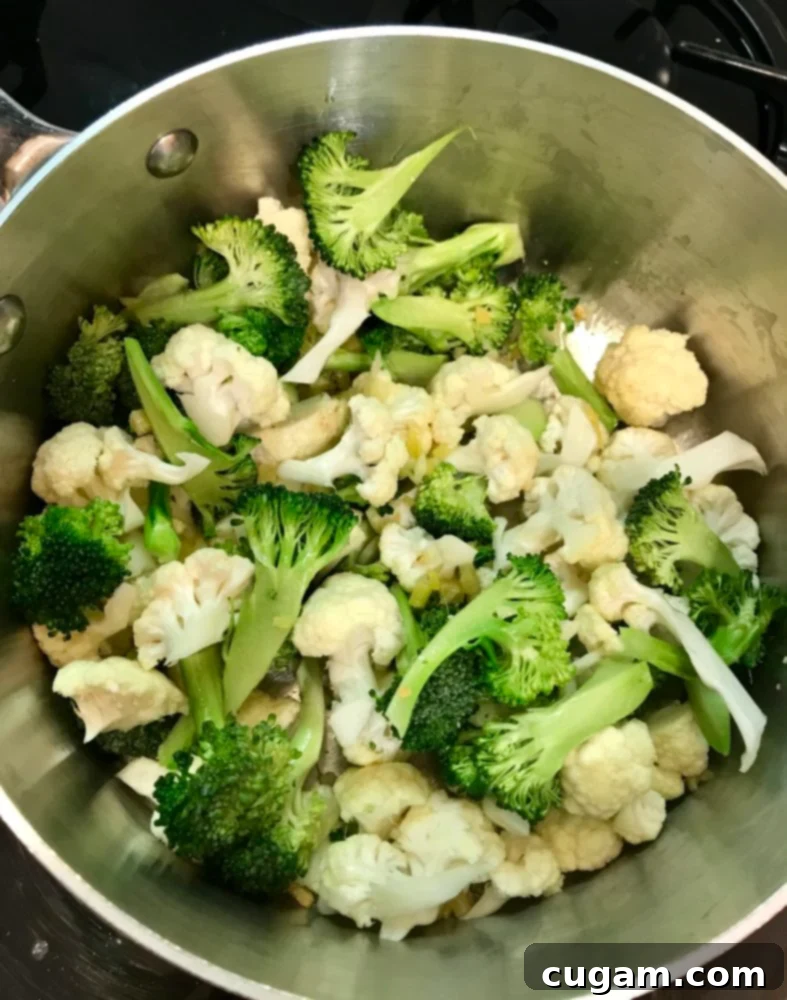
The Secret Behind This Simple Miso Soup’s Irresistible Flavor
The profound deliciousness of this soup stems from a few straightforward, yet crucial, techniques. It’s about building layers of flavor with fresh, unprocessed ingredients:
- Aromatic Foundation: The key begins with the quick sauté of fresh garlic and ginger. This initial step isn’t just about softening them; it’s about unlocking their essential oils and creating a fragrant, pungent, and warm base that permeates the entire soup. This brief sauté awakens their flavors and sets a delicious stage.
- The Miso Slurry: Another critical technique is creating a “slurry” with the miso paste and a cup of hot liquid from the pot *before* adding it back into the main broth. This prevents the miso from clumping and ensures it dissolves smoothly, distributing its rich umami flavor evenly throughout the soup. More importantly, it helps preserve the delicate probiotic properties of miso, which can be destroyed by high heat. Miso should always be added at the end, off the direct heat, to retain its beneficial live cultures.
- Fresh Ingredients: By using fresh, whole ingredients and minimal processing, we allow the natural flavors of the vegetables and the complex umami of the miso to shine. There are no hard-to-find or artificial ingredients here, just pure, wholesome goodness.
- Quick Cooking: The rapid cooking time for the vegetables ensures they retain their vibrant colors, crisp-tender texture, and maximum nutrient content. This prevents them from becoming overcooked and mushy, which can dull the soup’s appeal.
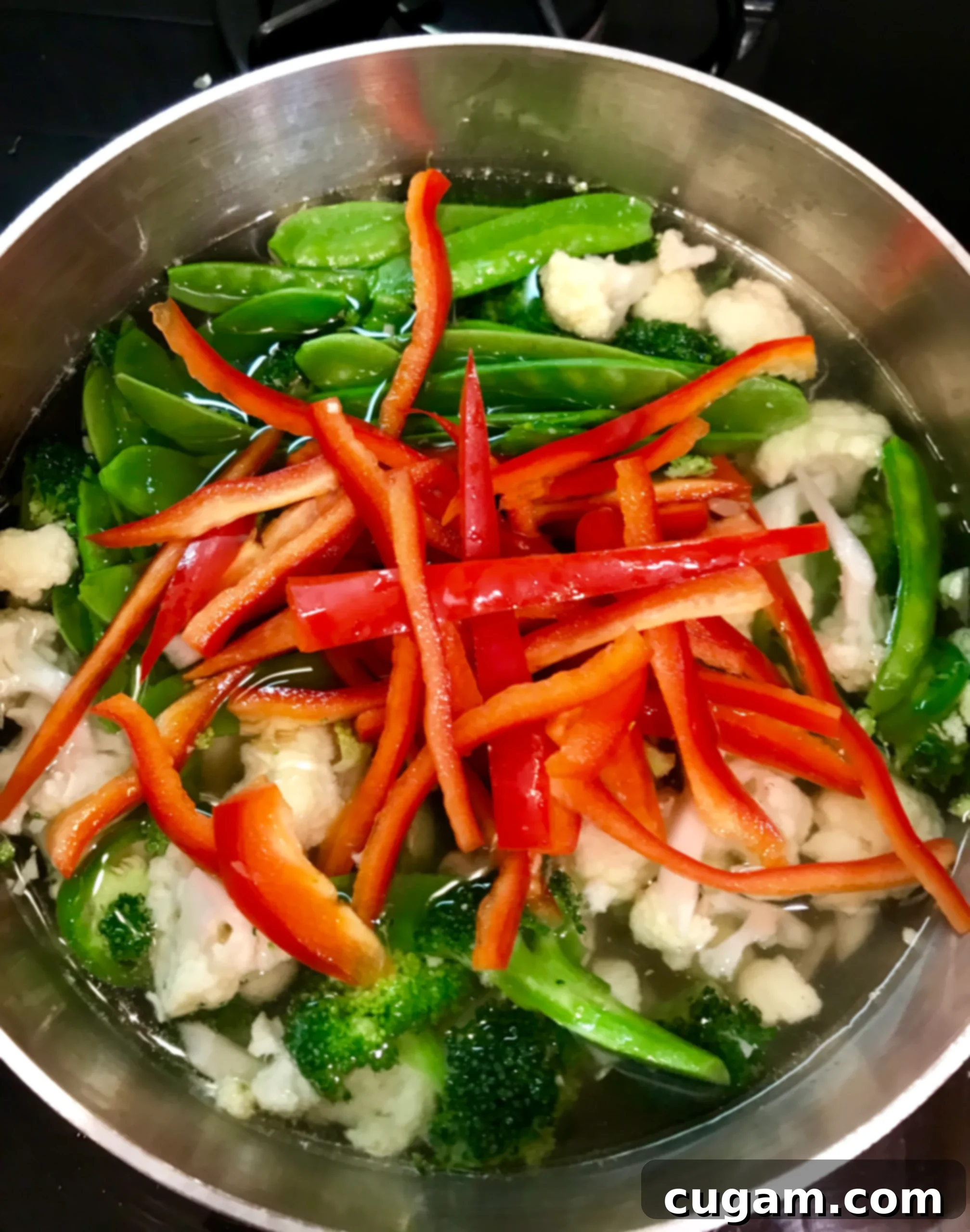
Debra’s Pro Tips for the Best Miso Soup
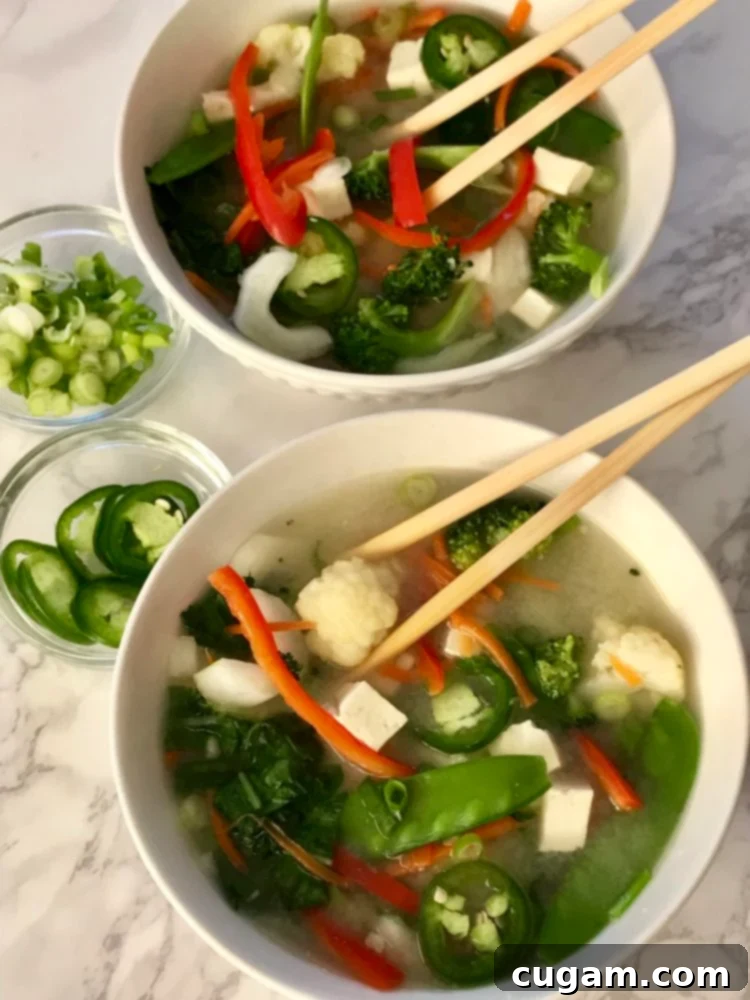
- Strategic Ingredient Prep: To save precious time, consider using pre-cut frozen veggies or those readily available from a salad bar. Alternatively, prep all your vegetables in advance so they’re ready to go when you start cooking. A little mise en place goes a long way!
- The Miso Dissolution Method: Always dissolve your miso paste in a separate cup with a bit of hot liquid from the pot before adding it back. As directed in the recipe card, this crucial step ensures the miso is perfectly incorporated, preventing any clumps and distributing its rich umami flavor smoothly throughout the soup. It also helps protect the beneficial probiotics from direct high heat.
- Don’t Skimp on Garnishes: Garnishes are not just for show; they add an extra layer of flavor and texture! My personal favorites are thinly sliced green onions (scallions) for their fresh, pungent kick and finely sliced jalapenos for a gentle warmth. Mung bean sprouts are also a delicious addition, offering a pleasant crunch and earthy taste. Fresh cilantro or a drizzle of sesame oil can also work wonders.
- Make it a Heartier Meal: If you’re looking to transform this light soup into a more substantial meal, consider adding rice noodles or kelp noodles. Cook them separately and add them to individual bowls just before serving. Cooked quinoa or a scoop of brown rice can also be wonderful additions.
- Cook Veggies in Stages: To achieve perfectly al dente vegetables—meaning tender-crisp, not mushy—add them to the miso broth in the order of how long they take to cook. Harder vegetables like carrots, broccoli, and cauliflower go in first. Softer, quicker-cooking greens like bok choy or spinach should be added last, often right before the heat is turned off.
- Choosing Your Broth Base: While water works well and allows the miso to shine, using a good quality vegetable broth or even a dashi (Japanese soup stock, easily made vegan) can add another layer of depth and umami to your soup.
- Tofu Preparation: For best results, gently press your firm or extra-firm tofu for about 15-30 minutes before dicing. This removes excess water, allowing the tofu to better absorb the delicious flavors of the soup and improving its texture.
Storage and Reheating Tips
This miso soup is best enjoyed fresh, but leftovers can be stored. It’s important to store the miso broth and any added noodles (if using) separately from the solid ingredients if possible, as miso can lose some of its probiotic benefits if continuously reheated, and noodles can get soggy.
- Refrigeration: Store leftover soup (without garnishes) in an airtight container in the refrigerator for up to 3 days.
- Reheating: Gently reheat the soup on the stovetop over low heat until warm. Avoid bringing it to a rolling boil, as this can diminish the delicate flavor of the miso and kill beneficial probiotics. If you separated the miso slurry, add it back during reheating or when serving. Add fresh garnishes just before serving.
- Freezing: Miso soup can be frozen without the miso paste. Freeze the vegetable broth, and once reheated, then whisk in fresh miso paste.
More Delicious Recipes That Use Tofu
If you’re looking for other creative ways to enjoy tofu, here are some fantastic recipes that highlight its versatility:
Tofu Satay: Delicious grilled tofu skewers served with an incredible, creamy peanut sauce. Perfect for a hearty appetizer or main course.
Tofu Scramble with Veggies: An easy and flavorful vegan alternative to scrambled eggs, perfect for a plant-based breakfast or brunch.
Crispy Baked Tofu: The ideal plant-based protein option for adding to buddha bowls, salads, stir-fries, or enjoying on its own.
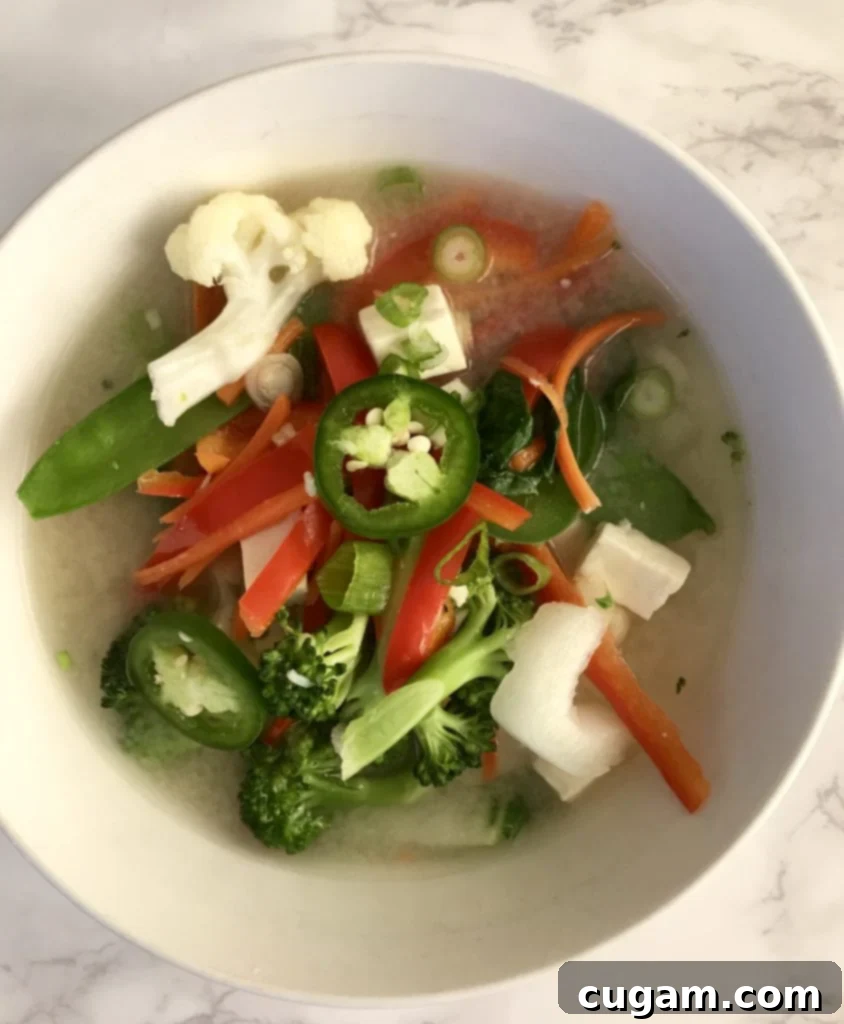
Did you know that commenting and rating recipes is one of the best ways to support your favorite food bloggers? If you made this recipe, please consider leaving a five-star rating below and a comment sharing your experience. Also, we’d love to see your creations! Please share your photos on instagram by tagging me @dkhealthcoach and using the hashtag #debraklein. Your support means the world!
📖 Recipe: Quick & Easy Miso Soup with Vegetables & Tofu
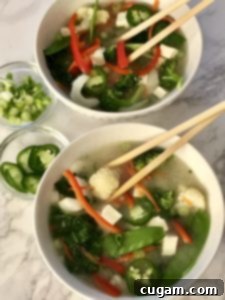
Simple Miso Soup with Vegetables and Tofu
Debra Klein
Rate this Recipe
Pin Recipe
5 minutes
5 minutes
10 minutes
Soup
Asian
4
servings
154
kcal
Ingredients
- 1 Tablespoon olive oil
- 1 Tablespoon minced fresh ginger
- 1 Tablespoon minced fresh garlic
- 1 cup broccoli florets
- 1 cup cauliflower florets
- 6 cups water (or vegetable broth)
- ½ cup snow peas trimmed
- 1 red pepper thinly sliced
- ½ head or one small bok choy, sliced thin
- ½ cup shredded carrots
- ¼ cup organic white miso paste
- 6 oz. organic firm tofu cut into small dice
- 1 jalapeno sliced into rounds (for garnish, optional)
- 3 scallions thinly sliced (for garnish)
Instructions
-
Build the Aromatic Base: Heat the olive oil in a saucepan over medium heat. Add the minced fresh ginger and garlic. Sauté for about 1 minute until fragrant and softened, being careful not to burn the garlic.
-
Add Hardier Vegetables: Toss in the broccoli and cauliflower florets to coat them in the aromatic oil. Cook for about 2 minutes, stirring occasionally, allowing them to slightly soften and absorb flavor.
-
Simmer & Add Remaining Veggies: Pour in the 6 cups of water (or vegetable broth) and bring it to a low boil. Stir in the snow peas next. After 1 minute, add the thinly sliced red peppers and shredded carrots to the pot. Continue to simmer for another 2-3 minutes, until vegetables are crisp-tender.
-
Incorporate Miso & Tofu: Ladle out 1 cup of the hot liquid from the pot into a separate small bowl. Add the organic white miso paste to this liquid and whisk well until the miso is completely dissolved, forming a smooth slurry. Turn off the heat under the main soup pot. Add the miso slurry back into the pot, along with the sliced bok choy and diced firm tofu cubes. Stir gently to combine.
-
Serve Immediately: Serve the miso soup piping hot. Pass around the sliced jalapenos and scallions as garnishes, allowing each person to customize their bowl with fresh, zesty flavor and a hint of spice. Enjoy!
Notes
Nutrition
Serving:
1
g
Calories:
154
kcal
Carbohydrates:
16
g
Protein:
10
g
Fat:
7
g
Saturated Fat:
1
g
Polyunsaturated Fat:
5
g
Sodium:
698
mg
Fiber:
5
g
Sugar:
6
g
Note
The nutrition calculations were done using online tools and are estimates. To obtain the most accurate representation of the nutritional information in any given recipe, you should calculate the nutritional information with the actual ingredients you used. You are ultimately responsible for ensuring that any nutritional information is accurate, complete and useful.
Did you make this recipe?
Please leave a review below, then snap a picture and tag me @dkhealthcoach or use hashtag #dkhealtcoach on Instagram so I can see it!!
Looking for more comforting soups? Try my Fall Harvest Minestrone Soup!
